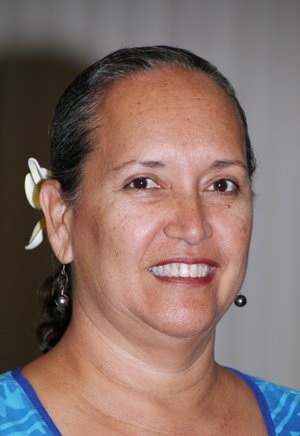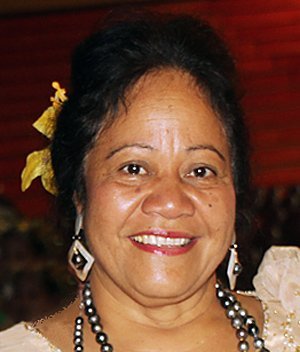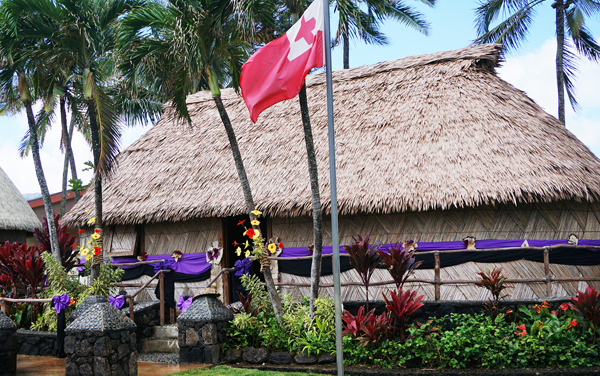Tongan Villagers at the Polynesian Cultural Center joined their compatriots in the South Pacific in mourning Her Majesty Queen Mother Halaevalu Mata’aho. She passed away at age 90 on February 19, 2017 in Auckland, New Zealand, where she had gone for medical treatment.

Queen Mother Mata’aho, photo courtesy of Deseret News
Queen Mother Mata’aho was the wife of Tonga’s late King Tupou IV, and mother of the late King Tupou V and current King Tupou VI. She is also survived by her daughter, Princess Mafile’o Pilolevu Tuita, 11 grandchildren and several great-grandchildren.
The entire Kingdom of Tonga observed the queen mother’s passing, including an official ten-day mourning period, which started on March 1 when more than 200 men carried her coffin to the Mala’ekula royal tomb in Nuku’alofa, the capital.
The Tongan royal family has maintained a presence in the Polynesian Cultural Center’s Tongan Village since the early 1960s when the late Queen Salote, mother of King Tupou IV, authorized a quarter-scale replica of her summer palace or fale fakatu’i be built in the PCC’s then-new Tongan Village. Queen Salote also sent two of her official builders to oversee the construction of the unique palace that is still the focal point of the Tongan Village.
 “We are deeply saddened at the passing of Queen Mother Mata’aho,” said Delsa Atoa Moe, PCC vice president of cultural presentations, which includes the Tongan Village. “She was a good friend of the Polynesian Cultural Center, and we were honored at the few times she was able to visit.”
“We are deeply saddened at the passing of Queen Mother Mata’aho,” said Delsa Atoa Moe, PCC vice president of cultural presentations, which includes the Tongan Village. “She was a good friend of the Polynesian Cultural Center, and we were honored at the few times she was able to visit.”
Moe pointed out that most recently His Majesty King Tupou VI and his wife, Her Majesty Queen Nanasipau’u, “reigned” over the official reopening of the Center’s renovated Tongan Village in June 2016.
“We are going to miss her, and we’re grateful for the influence she has had, not only on the people of Tonga but also here at the Center,” Moe said. “We express our condolences to the royal family of Tonga, and want them to know there is great love for them at the Polynesian Cultural Center.”
 Fifita Finau Unga, vice president of PCC’s food and beverage operations, added, “It was a memorable and special experience to meet Her Majesty Queen Mother Halaevalu Mata’aho in the Polynesian Cultural Center. I felt much gratitude and joy radiating from her countenance as she greeted the Polynesians here, and for her love of the people as she embraced them and shared her appreciation for our mission in preserving our culture.”
Fifita Finau Unga, vice president of PCC’s food and beverage operations, added, “It was a memorable and special experience to meet Her Majesty Queen Mother Halaevalu Mata’aho in the Polynesian Cultural Center. I felt much gratitude and joy radiating from her countenance as she greeted the Polynesians here, and for her love of the people as she embraced them and shared her appreciation for our mission in preserving our culture.”
 Tongan Village manager Alamoti Taumoepeau noted that he and his fellow islanders followed Tongan custom by draping the fale fakatu’i with the traditional mourning colors, black and purple, and setting up a photo tribute inside the building. In addition, we observed the government-decreed mourning period by flying the village flag at half-mast, and wearing traditional black mourning clothes. We also held a takipō or royal torch-lighting vigil on the eve of the queen mother’s burial in Tonga.
Tongan Village manager Alamoti Taumoepeau noted that he and his fellow islanders followed Tongan custom by draping the fale fakatu’i with the traditional mourning colors, black and purple, and setting up a photo tribute inside the building. In addition, we observed the government-decreed mourning period by flying the village flag at half-mast, and wearing traditional black mourning clothes. We also held a takipō or royal torch-lighting vigil on the eve of the queen mother’s burial in Tonga.
Taumoepeau, who grew up in Tonga, recalls that the queen mother was “very loved by many Tongans because of her charitable contributions and her love of the disabled. She was always involved with organizations such as the Tongan Red Cross and the women’s organization. She was a people person, and she was very influential.”

The fale fakatu’i at the Tongan Village of The Polynesian Cultural Center draped in mourning colors
A distant relative of the queen mother, Taumoepeau recalled that his grandmother, Mele Taumoepeau, grew up and went to school with the future queen and mother of kings in Kolomotu’a, Tongatapu. “When I mentioned her passing, my grandmother was in tears. She told us many stories while we were growing up. It’s as if we knew the queen mother ourselves. That’s something that we will never forget in our family,” he said.
“She and I personally last saw her about a year ago in Honolulu. She will be dearly missed.”
Story and images by Mike Foley

Mike Foley, who has worked off-and-on
at the Polynesian Cultural Center since
1968, has been a full-time freelance
writer and digital media specialist since
2002, and had a long career in marketing
communications and PR before that. He
learned to speak fluent Samoan as a
Mormon missionary before moving to Laie
in 1967 — still does, and he has traveled
extensively over the years throughout
Polynesia and other Pacific islands. Foley
is mostly retired now, but continues to
contribute to various PCC and other media.

Recent Comments